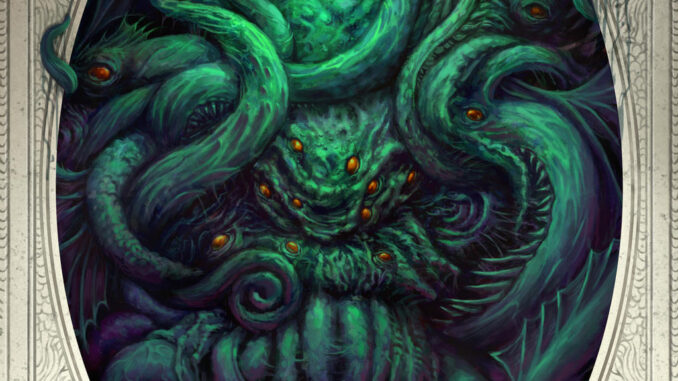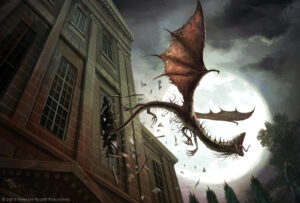
I recently completed a year-long trek through the epic Call of Cthulhu campaign Masks of Nyarlathohotep. The players were from my first roleplaying group, formed almost 25 years ago. Like many groups, we drifted physically apart from one another and convene on Skype and Roll20 for our weekly games. Like many Keepers in the last year, I’ve done my best to adjust to doing a lot of gaming on Roll20. Like most VTTs, it uses tokens to keep track of characters and monsters on the battlemap.
I wish I’d used blank tokens for the monsters.
Why? There’s a huge difference in the horror impact between a ghastly description of a Mythos-based creature and plopping a grotesque picture down on the board and saying, “You fight… well, this thing.”
It lacks the emotional punch. There’s no horror of the unknown. Unlike reading Lovecraft’s tales, there’s no theater of the mind where you create your own mental images of the monstrosities from Lovecraft’s words. The terror we create in our own imaginations is much greater than what is realized by an artist’s rendering. Maybe this is why Lovecraft stories have been rarely successful in their film adaptations.
By providing the accurate artist’s depictions of the Mythos creatures my group faced, I robbed them of the basic horror experience of visualizing the creature themselves. Because I reused the tokens when the Mythos entity was encountered in a different battle, the players recognized the monsters and knew their strategies and weaknesses. I made it even worse by revealing the creatures’ names when setting the battle map.
Without using tokens I could have said, “The mosque’s ancient foundation heaves as you cower in the basement. The sounds of tons of sandstone collapse overhead. Dust and debris find their way between the cracks. There’s a scream of shock as the elderly man left to guard the trapdoor is crushed beneath the collapsing mosque. Then, the darkness is punctured. Claws the size of swords rend the mosque’s floor. As the timbers are destroyed, you see backlit twisted worm-like bodies upon what might be a misshapen head. The head lunches forward, exposing a maw full of fangs. Its saliva pours down upon you.”
That’s what I should have said. Instead, I put a hunting horror token on the battle map and said, “The floors are ripped apart above you. Then, you see this creature moving in to attack.”
 A player asked, “Is that a hunting horror?”
A player asked, “Is that a hunting horror?”
I replied, “That’s a hunting horror all right. Make a Sanity roll.”
The players should never have known what they were fighting. It doesn’t matter if my group was familiar with the creatures of the Cthulhu Mythos or not. Most of my players weren’t, but after their third battle with the creature represented by that token, they knew what they were up against. They didn’t fear the entity.
In the Malleus Monstrorum, the bestiary for Cthulhu Mythos creatures, the writers suggest to never reveal the monsters’ names and never let them behave the same. These creatures are alien. Humans cannot make sense of their motives nor their tactics. The monsters’ tactics should be mixed up each fight. These are not typical goblins, which every player of a level one Dungeons and Dragons character has fought. These are creatures whose very essence shatters sanity. They behave however they want to, and it doesn’t have to make any sense.
Mentioning Dungeons and Dragons, I’m reminded of something Guy Sclanders said. “If you change the number of hit points a monster has, and a player says, ‘No, the Monster Manual says the monster should have this amount of hit points,’ say, ‘The monster gets a free attack against your character. Do you have anything else you’d like to say?’”
Sly Flourish suggests altering the Dungeons and Dragons monsters’ hit points within the range of their hit dice, allowing for greater challenges. Also, doubling their hit points and adding an extra attack creates a dire version of whatever monster you have a stat block for.
The point is that in any game the characters should not have a complete technical manual of the creatures they face. If a character has never before seen an owlbear, the DM shouldn’t say, “You’re fighting an owlbear” but rather should describe the scene and let the horror of the fight sink in as the hooting four-legged machine of death tears the party limb from limb.
By not using the appropriate miniature or using the monster’s proper name, you keep the players guessing at what they’re up against and allow their imaginations to grasp at the Keeper’s descriptions, so that their mental image will likely be ten times more frightening than any artist’s depiction.

Heh, reminds me of a recent D&D session where we battled a long-armed abomination whose mere presence twisted space so badly that our weapons disjoined or bent impossibly as we attacked. What was this creature of reality-warping madness?
A displacer beast with the serial numbers filed off.